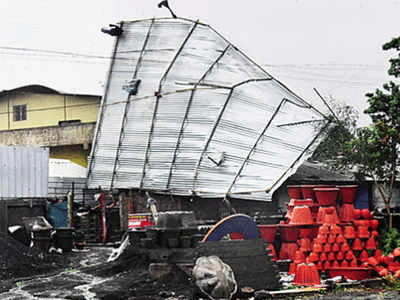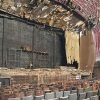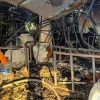Goa is abuzz with excitement as vintage bike and car owners, users, collectors and fans are decking […]

MASS MIGRATION OF URBAN LABOR!
In the News, May 22-May 28,2021 May 21, 2021DEVASTATION: Pune is an industrial hub of the country, particularly the automobile industry which has been badly hit by the cyclone. The district is already in lockdown and this has led to the mass migration anew of industrial workers back to their home states.
By Arvind Pinto
The cyclone has compounded the Covid-19 effect causing widespread damage to industrial units in Maharashtra and particularly in the main hubs like Pune and Nasik. While the positivity rate is falling, black fungus has reached alarming proportions, with Uddhav Thackerey calling it an epidemic.
EVEN as the positivity rate of the spread of Covid-19 begins to drop, the western coast of the state of Maharashtra was hit by Cyclone Tauktae bringing death and destruction in its wake. As I sit to write this piece the cyclone has gone but left in its wake a lot of destruction by way of fallen trees and piles of green foliage piling up everywhere and all around me. Let’s look at the impact of these two events on the lives of Mumbai.
The economic effects of the second wave
Unlike the first corona virus infection wave last year, this second wave has a subtle but distinctly different effect on the economy. The downturn last year saw the fall of the stock market as a shock reaction to the lockdown. Further, the mass migration of daily labour from the cities, was the result of a fall in urban employment — due to the severe Covid-19 lockdown. With manufacturing dislocated and transportation disrupted, supply chains were hit – the next thing we know is the shortages in certain key areas.
Our seemingly trillion-dollar economy in the making is in shambles. The good aspects in the last year were with a substantial agricultural production, inflationary pressure was minimal. Thus, although fiscal deficit even by government figures was high at around 5%, Finance Minister Nirmala Sitharaman in her budget speech exuded confidence that the economy would recover in the new fiscal year beginning April 2021.
Therefore, when the lockdown restrictions were lifted end-2020, there was an immediate rise in pent-up demands for essentials. This surge created the green shoots in the economy that many analysts saw as a rebound of demand that would quicken the pace of the economy.
This gave rise to rating agencies heralding the quickening of the economy. There was talk of a V-shaped recovery, with growth rate slated to be as optimistic as 12% of the fiscal year 21-22. The interesting aspect of all these projections is that none of the economists or rating agencies were able to foresee or even portend the coming of the second sudden coronavirus surge of infection attacking the lungs.
This second wave of the double mutant viral contagion witnessed a different economic scenario. This second wave cut across class and economic strata, affecting even the rich and the powerful. Suddenly the perspective has changed with anyone from the house maid to the possiblity everyone from you catching the virus from your maid, to the possibility of the employer and his family contacting the infection and spreading it around to family, friends, colleagues in whose company they may be albeit at brief intervals.
This second wave sees the breakdown of medical infrastructure with overwhelming pressure on hospital beds, oxygen supply, medicines, nursing care and other scares. Sad to say even a decent burial or cremation is hard to get. This has brought about a sense of uncertainty amongst the middle and upper class strata of our urban population. This uncertainty has paralysed demand in a significant manner. The demand for housing, cars, luxury goods, and several non-essentials has fallen. The change in patterns of spending of the rich and middle classes will impact the economy in a significant manner. Economists have still to study the effects of these changes.
Response by the Reserve Bank of India
IN the wake of this second wave the Reserve Bank of India has set guidelines to help borrowers in their loan credits. In the case of individual borrowers and loans availed for small businesses not more than Rs25 crore, the guidelines are rather liberal. Directions include rescheduling of payments, conversion of interest accrued or to be accrued into another credit facility, revision of working capital sanctions and even granting of a moratorium based on the assessment on income stream of the borrower. Further, this rescheduling of accounts would be considered standard and not fall into the stressed loan category. Banks are authorised to grant a moratorium for a period of two years.
Even as I write this piece as cases of Covid-19 are declining there is despondency in the air. Banks are flush with funds but there is little off take and enquiries for new funding. Most banks are content to park their surplus funds in government securities or with the RBI, content to earn a minimum but secured return on their monies.
Stagnation will not revive the economy. Both government and the RBI are accommodative to push money into the market, but unless the investment drive accelerates there will be little by way of economic growth.
What ails the economy?
WITH much uncertainty, both the upper and middle classes prefer to remain in cash should the need arise. For the costs of Covid-19 are indeed still very expensive and unaffordable for the many. At the height of the shortages a bed in a decent hospital, with continuous oxygen monitoring, could raise the billing by around Rs50,000 per day! Even ambulances are hard to come by. Even after care is expensive, with the need for rest and medication for more than a month after recovery from the debilitating infection.
The vaccination drive that began in the month of February 2021 was comparatively well managed. With an efficient registration program, several of those above the age of 60 years were in a position to obtain their first shot of the vaccine without too much procedural problems. With the second wave of the pandemic there is the inevitable shortage of the second dose for those who have taken the first shot.
Now with all above 18 year olds entitled to take the vaccine, there is pandemonium at many of the allotted vaccination centres. Several private hospitals have had to discontinue their programs since no vaccines are being supplied. If there are lines to be seen in Mumbai, it’s generally before a hospital where the vaccination drive is operative!
Adding to the deadly corona virus woes came the cyclone which hit the coastal states, with high velocity winds swirling around and causing massive uprooting of trees, power outages and consequent disruption in transport. While the loss of lives on the two barges off Mumbai High waters going adrift was indeed sad, around 180 men were rescued by the Navy. Fortunately, there was no significant loss of life on land, but the destruction of many flimsy homes and agricultural crops has yet to be estimated.
The month of not so merry May this eyar has been a month of misery vis-à-vis loss of life due to Covid-19 and Cyclone Tauktae. While both waves have flattened dazed citizens of the metropolis are beginning to pick up the threads of life anew with the renewed hope of a better tomorrow!















